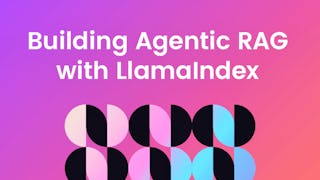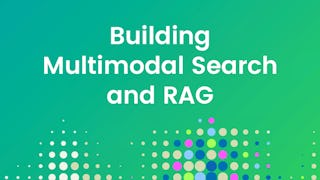Data Scientists, AI Researchers, Robotics Engineers, and others who can use Retrieval-Augmented Generation (RAG) can expect to earn entry-level salaries ranging from USD 93,386 to USD 110,720 annually, with highly experienced AI engineers earning as much as USD 172,468 annually (Source: ZipRecruiter).



Build RAG Applications: Get Started
Ce cours fait partie de IBM RAG and Agentic AI Certificat Professionnel


Instructeurs : Wojciech 'Victor' Fulmyk
Inclus avec 
Expérience recommandée
Ce que vous apprendrez
Develop a practical understanding of Retrieval-Augmented Generation (RAG)
Design user-friendly, interactive interfaces for RAG applications using Gradio
Learn about LlamaIndex, its uses in building RAG applications, and how it contrasts with LangChain
Build RAG applications using LangChain and LlamaIndex in Python
Compétences que vous acquerrez
- Catégorie : Generative AI
- Catégorie : Artificial Intelligence
- Catégorie : Application Frameworks
- Catégorie : Prompt Engineering
- Catégorie : Jupyter
- Catégorie : User Interface (UI)
- Catégorie : Application Development
- Catégorie : Natural Language Processing
- Catégorie : Large Language Modeling
Détails à connaître

Ajouter à votre profil LinkedIn
mai 2025
6 devoirs
Découvrez comment les employés des entreprises prestigieuses maîtrisent des compétences recherchées

Élaborez votre expertise en Machine Learning
- Apprenez de nouveaux concepts auprès d'experts du secteur
- Acquérez une compréhension de base d'un sujet ou d'un outil
- Développez des compétences professionnelles avec des projets pratiques
- Obtenez un certificat professionnel partageable auprès de IBM


Obtenez un certificat professionnel
Ajoutez cette qualification à votre profil LinkedIn ou à votre CV
Partagez-le sur les réseaux sociaux et dans votre évaluation de performance

Il y a 3 modules dans ce cours
This module provides an overview of Retrieval-Augmented Generation (RAG), illustrating how it can enhance information retrieval and summarization for AI applications. The module features a lab designed to introduce the fundamental components of building RAG applications, presented in an easy-to-use Jupyter Notebook format. Through this hands-on project, you’ll learn to split and embed documents and implement retrieval chains using LangChain.
Inclus
3 vidéos2 lectures2 devoirs1 élément d'application1 sujet de discussion3 plugins
In this module, you'll learn to build a Retrieval-Augmented Generation (RAG) application using LangChain, gaining hands-on experience in transforming an idea into a fully functional AI solution. You'll also explore Gradio as a user-friendly interface layer for your models, setting up a simple Gradio interface to facilitate real-time interactions. Finally, you'll construct a QA Bot leveraging LangChain and an LLM to answer questions from loaded documents, reinforcing your understanding of end-to-end RAG workflows.
Inclus
1 vidéo1 lecture2 devoirs2 éléments d'application2 plugins
This module introduces you to LlamaIndex as an alternative to LangChain, helping you understand how to apply your RAG knowledge across different frameworks. You will explore the differences between these frameworks and gain hands-on experience by building a bot with IBM Granite and LlamaIndex that provides individuals with suggestions on engaging in conversations. When completing this project, you will learn about implementing key concepts such as vector databases, embedding models, document chunking, retrievers, and prompt templates to generate high-quality responses.
Inclus
3 vidéos3 lectures2 devoirs1 élément d'application2 plugins
Offert par
En savoir plus sur Machine Learning

DeepLearning.AI

DeepLearning.AI

Google Cloud
Pour quelles raisons les étudiants sur Coursera nous choisissent-ils pour leur carrière ?





Ouvrez de nouvelles portes avec Coursera Plus
Accès illimité à 10,000+ cours de niveau international, projets pratiques et programmes de certification prêts à l'emploi - tous inclus dans votre abonnement.
Faites progresser votre carrière avec un diplôme en ligne
Obtenez un diplôme auprès d’universités de renommée mondiale - 100 % en ligne
Rejoignez plus de 3 400 entreprises mondiales qui ont choisi Coursera pour les affaires
Améliorez les compétences de vos employés pour exceller dans l’économie numérique
Foire Aux Questions
RAG improves the quality of responses generated by LLMs by grounding answers in up-to-date, authoritative external data to reduce errors and hallucinations. It enables LLMs to provide more accurate, context-aware, and reliable outputs, often with source citations, even for topics outside their original training data, which results in higher trustworthiness and relevance in AI-generated responses. (Source: GoPractice.io)
Retrieval-augmented generation (RAG) is important for AI professionals because it improves the accuracy and reliability of AI models by grounding their responses in up-to-date, real-world information, which reduces the risk of incorrect or outdated outputs. RAG also enables faster adaptation to new domains without extensive retraining, making AI solutions more flexible and cost-effective.
For AI professionals, mastering RAG means building more transparent, context-aware, and dependable AI systems, making the ability to implement RAG an essential skill as demand for trustworthy and explainable AI continues to grow across industries.
The job outlook for professionals with RAG (Retrieval-Augmented Generation) skills is highly promising, with demand rapidly increasing as industries like healthcare, finance, legal, and customer service adopt RAG. With the RAG market projected to grow at over 49.2% CAGR through 2034, professionals with these skills can expect strong job opportunities, competitive salaries, and career growth across multiple sectors. (Source: Precedence Research)
Plus de questions
Aide financière disponible,


